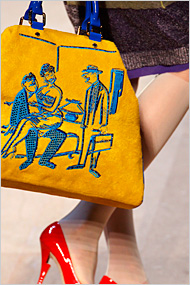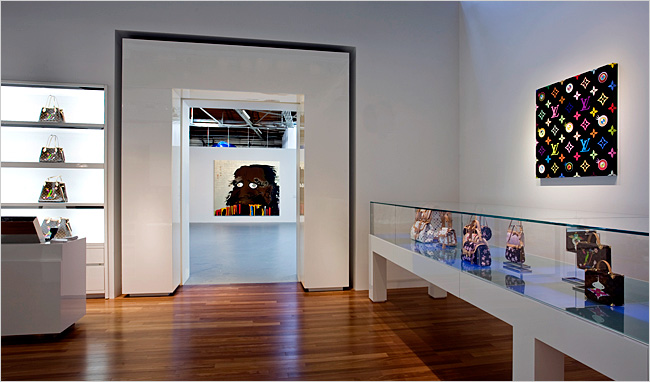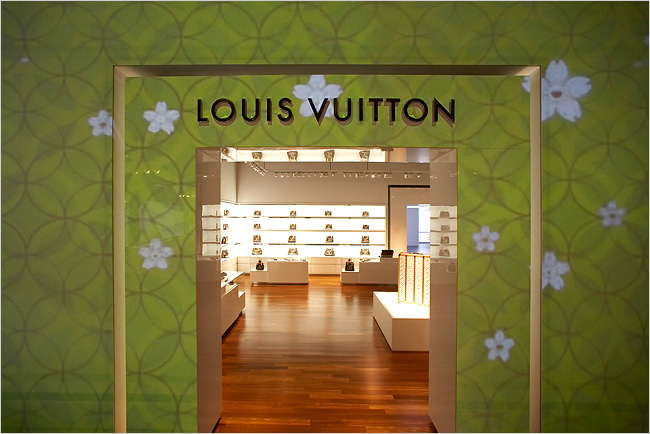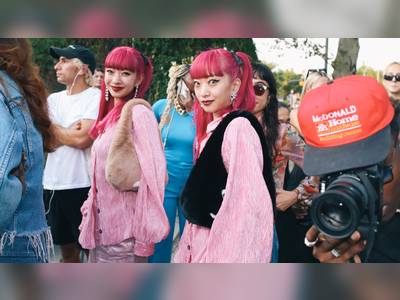
Pierre Verdy/Getty Images (handbag)
Ms. Evilsizor, who had come from San Francisco nominally to see an exhibition of paintings and sculpture by the Japanese artist Takashi Murakami, was delighted. Here was a luxury store — operated by Louis Vuitton, no less — in the midst of a high-tone exhibition space.
She was even able to snare a trophy, a handbag designed by Marc Jacobs, the Vuitton creative director, with the company’s monogram — and one of Mr. Murakami’s raucously colorful cartoon images. Sizing up the haute Bohemian crowd milling about in T-shirts, premium jeans and pricey knee-high boots, she noted, “There’s definitely a large percentage of people who are here for the purses.”
Visitors were indeed snapping up the limited-edition leather goods, embellished with Mr. Murakami’s cartoon hands and Chibi Kinoko mushroom-shaped characters. And most seemed to sense that they were witness to a marriage made in mercantile heaven.
The show, with its $960 handbags and $695 agendas for sale, created a flap even before its opening on Oct. 29. Art-world purists charge that it has eroded the line between culture and commerce. “It has turned the museum into a sort of upscale Macy’s,” the art critic Dave Hickey chided in an interview.
Still, at a time when artworks are purchased like luxury goods — the on-canvas equivalent of a Lamborghini or Revillon sable-lined raincoat — the shop-within-the-show serves as a rarefied marketing tool. It provides a glossy platform for both merchant and artist seeking to extend his brand, one that ideally confers a cachet that translates into galloping sales.
The first deluxe boutique to be integrated in a formal exhibition, the Murakami-Vuitton store is “a terrific example of not just the artist embracing commercial success but proactively going after it,” said Elizabeth Currid, the author of “The Warhol Economy: How Fashion, Art and Music Drive New York City” (Princeton University Press, 2007). In this kind of venture, everyone profits, Ms. Currid said. “You are creating a new kind of product, one that expands the economic horizons of all the parties involved.”
That venture has also trained a spotlight on a trend that is picking up steam. True, artists have aligned themselves with luxury brands since the 1930s at least, when Salvador Dalí and Jean Cocteau placed their surrealist stamp on fashions by Elsa Schiaparelli. But such formerly rare and mostly unsung unions are now increasingly common — and profitable. Small wonder, then, that artists of the stature of a Damien Hirst or Richard Prince are vying to lend their imprimatur to a range of designer goods.
“Artist products are the current thing,” said Jeffrey Deitch, the art dealer and a former associate of Andy Warhol, the acknowledged master of artist self-branding. A generation ago, the mating dance between culture and commerce was regarded as heresy, Mr. Deitch acknowledged. But today, he added, such alliances are “just one of the avenues available to the artist who wants to get his message to the public.”
Exhibit A: Mr. Murakami. Before he teamed up with Vuitton five years ago, he was known primarily to art aficionados. That collaboration was a marketing tour de force so spectacular that it created a waiting list in the thousands for the artist-bags. Indeed, a case could be made that it turned Mr. Murakami into a celebrity viewed by his fans as the pudgy, goateed Heath Ledger of the art world.
So where’s the rub? Mr. Murakami made his name, after all, by taking the culture of branding as his primary subject. Tellingly, his show is titled “© Murakami.”
And yet the installation — a shop that lines the pockets of the artist and his corporate partner — would appear to compromise the authority and curatorial role of the Museum of Contemporary Art. Not so says Paul Schimmel, the museum’s chief curator. He pointed out that the museum receives no rental fees or profits from the store. To do so would place its nonprofit status at risk.
Vuitton did not pay for the show; however, it did underwrite a splashy opening-night party that attracted celebrities like Cindy Crawford, Naomi Campbell and Pharrell Williams.
Mr. Schimmel further maintained that the boutique is integral to the artist’s message. “One of the most radical aspects of Murakami’s work is his willingness both to embrace and exploit the idea of his brand, to mingle his identity with a corporate identity and play with that,” he said. “He realized from the beginning that if you don’t address the commercial aspect of the work, it’s somehow like the elephant in the room.”
Such arguments have done their part to defuse potential controversy. The museum, said Gail Andrews, director of the Birmingham Museum of Art in Alabama and president of the Association of Art Museum Directors, “has made the case that luxury goods are a part of Murakami’s artistic expression. They are doing what contemporary museums do, pushing the boundaries.”
To say nothing of luring
visitors into the tent. Indeed, the museum has been a major beneficiary
of the collaboration. “We are certain that it has brought audiences and
visibility to MOCA,” Mr. Schimmel said.

That wisdom was not lost on Levi Strauss. Last year the company attempted to boost its hip quotient by issuing Warhol Factory X, a line of jeans embroidered or printed with familiar Warhol touches: Marilyn patches, squiggles, newsprint patterns. This year, seeking to trump its own success, it joined forces with Mr. Hirst, the British art renegade. Today trophy hunters who can’t afford a Hirst skull, spot or splatter painting can aspire to the diffusion line, in which denim is the canvas for familiar motifs extracted from Mr. Hirst’s iconic works. Call it the rag trade answer to a lithograph.
In recent years Fendi and the luggage label Longchamp have traded on the luster of art-world names. Longchamp, in an effort to inject brashness into its somewhat fusty image, joined forces with Tracey Emin, the British artist notorious for incorporating condoms, cigarette butts and other detritus of her private life into her artwork.
This year Mulberry enlisted the London artist Julie Verhoeven to embellish a collection of bags, scarves and dresses with her erotically charged mélanges of flowers and girlish faces.
No marketing laggard, Mr. Jacobs, a collector of artworks by John Currin, Elizabeth Peyton and Mr. Prince, lent the art-slash-fashion trend fresh impetus this fall by inviting Mr. Prince to conceive a handbag line for Vuitton. The partnership could not have been better timed: a 30-year survey of the artist’s work is at the Guggenheim Museum. And the company is betting that the bags, some stamped with cartoons, will appeal to the same affluent tastemakers who regard Mr. Prince as a household name.
“If you look at the world of art people interested in contemporary art, they are usually interested in luxury,” said Yves Carcelle, the president of Louis Vuitton. “The bridge between the two worlds is more and more obvious.” Mr. Carcelle underscored the point by noting that 60 of the MOCA Murakami bags were sold in the show’s first week alone.
Referring to the original Murakami leather goods, Mr. Carcelle added, “For us, the payoff has been extraordinary.” He declined to break out sales figures but said that the Murakami profits, which account for only a small percentage of the Vuitton business, add up to more than the total profits of some competing brands.

Such products, a kind of art couture, appeal primarily to a rising class of affluent culture chasers, “people who are very focused on having those hip luxury signifiers,” in the words of Simon Doonan, the creative director of Barneys New York. Owning such products “signifies informed consumption,” Mr. Doonan said. “They say: ‘I’m not just a shopper. I’m a super groovy shopper.’”
That assertion would get no argument from Ellen Black, a San Francisco artist who had come to see the Murakami show. Even visitors only marginally acquainted with Mr. Murakami’s signature imagery, she noted, perceived the Vuitton handbags as a get. “It’s interesting how the people who buy them are parading them around,” she said. “To them, the image on this bag becomes like a badge.”
It does make you wonder, she said.













